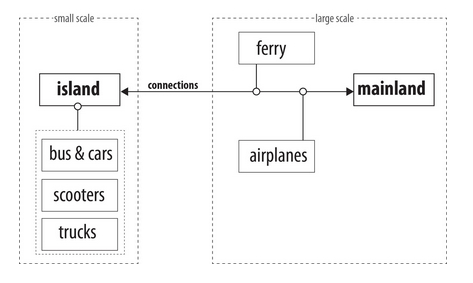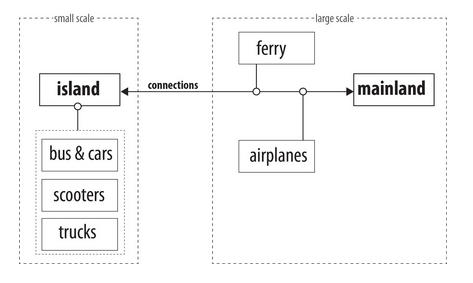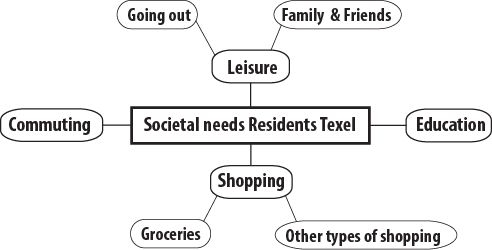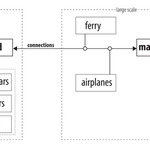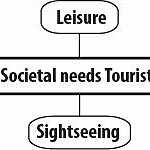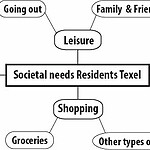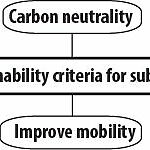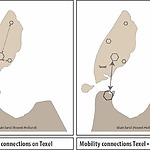1.1 Scale and focus of unsustainabilities
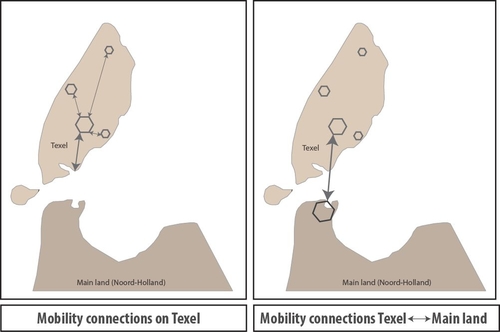
Figure 1.1.1. Mobility connectors on Texel and between Texel and mainland.
The mobility on Texel rests on different means of transportation which vary in terms of scale and connection. The one ferry line departs from Den Helderand and connects the island with the mainland. It has been the main connection to outside since it seems to be the cheapest and most convenient mean to get on or off the island. The crossing takes 20 minutes and leaves at 30 minutes past the hour from 6.30am to 9.30pm; returning boats leave on the hour between 6am to 9pm. On some summer days there’s a service every half-hour. The Texel International Airport was founded more than 70 years ago. Annually 20-25,000 flight departures and landings take place at the airport. Alongside parachute jumping and round-the-island flights, the airport is often visited by national and international sport aircraft. These planes are used both privately and commercially. Many professional aviation schools use Texel as an in-between landing stop during flight lessons. The Texel airport is also used by police, coastguard and environmental aircraft. The airport has two exceptional grass runways which can be used by many types of aircraft in the summer months. Texel Airport is becoming increasingly popular amongst both private owners and companies as an alternative for the ever busier road traffic. The airport is open all year round and offers restaurant and hotel facilities plus and unique Aviation and Wartime Museum.These two options (ferry and airplane) can be investigated in the large scale, while the mobility on the island can be seen in a smaller scale because it transports people shorter distances on the ground, see figure 1.1.1 The smaller scale unsustainabilities can be divided into three subcategories for a systemic-based analysis. These three categories are: a. trucks (freight transport), b. private cars and bus and c. scooters, see figure 1.1.2. Each one of them might have different destination or purpose and therefore different impact either on the natural environment or local society’s and visitors’ (tourists) behavior. All the means of transportation can be analyzed among with the frequency of the need for transportation as well as its capability to service the population of the island.
Figure 1.1.2. Scale of unsustainable mobility on Texel.
1.2 Societal needs
The sub-system has to fulfill needs regarding the mobility of the Texelaars and the tourists visiting Texel. Since the mobility needs are seen as different for these two groups, the description of their respective needs are divided. See figures 1.2.1 and 1.2.2. for an overview.
Local inhabitants (Texelaars)
Local inhabitants need to be able to transport themselves to and from work and school. The destination can in this case be both on the island and on the mainland. The Texelaar also needs to be able to fulfill “basic needs”, such as grocery shopping, pharmacy visits, doctors appointments, and other kinds of shopping. In addition to that, leisure activities such as trips to see relatives or trips to certain activities and hobbies need to be taken into consideration.
Figure 1.2.1 Societal needs of residents on Texel.
Tourists
Tourists that arrive on Texel will first and foremost need transport between ferry terminal and hotels/camping. In addition to that, they will also have to sustain their “basic needs” in connection to the location of their stay. Leisure travel and sightseeing will by far be the most important aspect of mobility for tourists, who need to be able to transport themselves to certain attractions and sites all over the island.
Figure 1.2.2. Societal needs of tourists on Texel.
1.3 Sustainability criteria
As seen in figure 1.3.1 we have defined 4 criteria for the subsystem of sustainable mobility of Texel. These are carbon neutrality, societal support, improved mobility and without harming the environment.
Figure 1.3.1. Sustainability criteria for the subsystem.
Carbon neutrality
By aiming for carbon neutrality in the subsystem, the bar has been set quite high. With carbon neutrality, it is meant the reduction of all possible emissions and impacts and a contribution to a measured reduction elsewhere to balance the rest (Global carbon project).
Societal support
In order for sustainable mobility to thrive on the island, support of the local Texelaars is needed. To gain local support, transparency and clear communication is key. Without these two elements, misperception is easily created, which is strongly associated with general reduced levels of policy support and implementation (Ding, Maibach, Zhao, Roser-Renouf, & Leiserowitz, 2011).
Improved mobility
The third criterium for the sustainable mobility, is an improved mobility. With this criterion, it is of utmost important to map the current dissatisfactions about the subsystem and aim to solve these issues. This does not necessarily mean more frequent and more connections, but rather focusses on improving the quality of the mobility over the quantity, whilst making it more sustainable at the same time.
Harmless for the environment
The last criterion, is that the transition into a sustainable mobility system, cannot lead to harmful effects to the environment. This criterion will have to be subdivided into other subcriteria, such as noise levels, horizon pollution and so on.
Sketch of future system
Based on the above, we can draw an outline of the future socio-technical mobility system for Texel.The scope of the research (mobility) is defined as all the traffic of human beings and goods on and across the border of the island. These forms have been established and quantified. Since Texel is an island we can establish that it is locked-in to certain forms of mobility. Since there is no bridge or tunnel available, visitors will need to use the ferry or a plane to arrive at the island. This lock-in however is not yet an entrenchment, it is still possible to adapt these forms of transportation.
The research criteria are based on mobility systems that fulfill both the societal needs of the inhabitants and visitors of Texel, as well as the sustainability criteria listed above. From the multi-level perspective as described by Geels (2004), these research criteria could be considered as the socio-technical regimes in the new socio-technical system. To establish these regimes in society, the old regimes will need to be removed. Since mobility is a part of everyday life, any change to a mobility system will influence the users of that system, for instance the inhabitants, entrepreneur and visitors of Texel. The objective of this research is not only to select certain technological niches which could be implemented in the new mobility system, but also to incorporate the values and interests of the actors in the socio-technical system. This so-called Value Sensitive Design will help to minimise resistance in society (Pesch, 2014).
Summarising, three problems that need to be faced during this research can be listed:
- Finding technological niches that could improve, or (partly) replace the current mobility systems on Texel.
- Selecting and shaping these technological niches using the research criteria.
- Incorporating values and interests of actors involved in order to minimise resistance to change from the users.
Our research question is therefore formulated as follows:
How can the mobility need of both the visitors and inhabitants be met in terms of a sustainable transport system?
References
Ding, D., Maibach, E. W., Zhao, X., Roser-Renouf, C., & Leiserowitz, A. (2011). Support for climate policy and societal action are linked to perceptions about scientific agreement. Nature Climate Change , 1, pp. 462-466.
Geels, F. W. (2004). From sectoral systems of innovation to socio-technical systems Insights about dynamics and change from sociology and institutional theory . Research Policy , 33, pp. 897-920.
Global carbon project. Carbon Neutral. Collected from Global carbon project: http://www.globalcarbonproject.org/carbonneutral/ the 29th of November 2014
Pesch, U. (2014). Engineers and Active Responsibility . Science and Engineering Ethics . DOI 10.1007/s11948-014-9571-7
